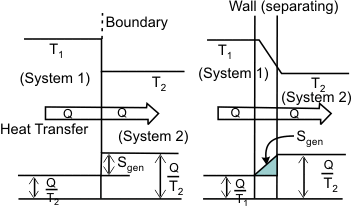Loss of Available Energy due to Heat Transfer through a Finite Temperature Difference
Suppose a certain amount of energy Q is transferred as heat from a body at constant temperature  to a body at constant temperature to a body at constant temperature  . .
Because of the finite temperature difference between the two interacting bodies, the energy transfer is an irreversible process. This irreversibility leads to a loss in the available energy. This loss in the available energy would not have occurred, had a reversible engine been employed to transfer the energy from the body at  to the body at to the body at  . .
Suppose the same quantity of energy Q is absorbed by a reversible engine. Before the energy transfer takes place the energy is available at temperature  . After the energy transfer the energy is available at a lower temperature . After the energy transfer the energy is available at a lower temperature  . Let the ambient be at a temperature . Let the ambient be at a temperature  . .
Then the initial available energy  |
(25.4) |
the final available energy  |
(25.5) |
Therefore the loss of available energy
 |
(25.6) |
 |
(25.7) |
Where  is the change in the entropy of the universe. It implies that whenever is the change in the entropy of the universe. It implies that whenever  , there is a loss in the available energy. , there is a loss in the available energy.
The second law of thermodynamics states that,  , where the equality is true for reversible processes and the inequality is true for all Spontaneous or irreversible processes. Therefore, all spontaneous or irreversible processes are associated with a loss of available energy. , where the equality is true for reversible processes and the inequality is true for all Spontaneous or irreversible processes. Therefore, all spontaneous or irreversible processes are associated with a loss of available energy.
Note that though the same amount of energy as heat is available before and after the irreversible energy transfer, the available energy is less at  compared to the available energy at compared to the available energy at  . That is, there is a degradation in the quality of the energy. The internal energy at lower temperature is considered as degraded energy. We have seen that all the energy absorbed as heat cannot be converted into work. That is, the internal energy of a reservoir or a body is a low quantity energy. . That is, there is a degradation in the quality of the energy. The internal energy at lower temperature is considered as degraded energy. We have seen that all the energy absorbed as heat cannot be converted into work. That is, the internal energy of a reservoir or a body is a low quantity energy.
On the other hand, work is considered as the highest quality of energy, because it is interchangeable to the other forms with hundred percent energy conversion efficiency. It is possible to convert work completely into internal energy, but not vice-versa .
The entropy generation associated with a heat transfer process can be well explained by Figure 25.3 (a) and (b).

Figure 25.3
In Figure 25.3 (a) the presence of a well is ignored. The quantity  signifies entropy transfer. signifies entropy transfer. It is clear from both the cases, that whenever energy is transferred through a finite temperature difference, entropy generation is brought about. Entropy generation is an obvious outcome of an Irreversible process.
|